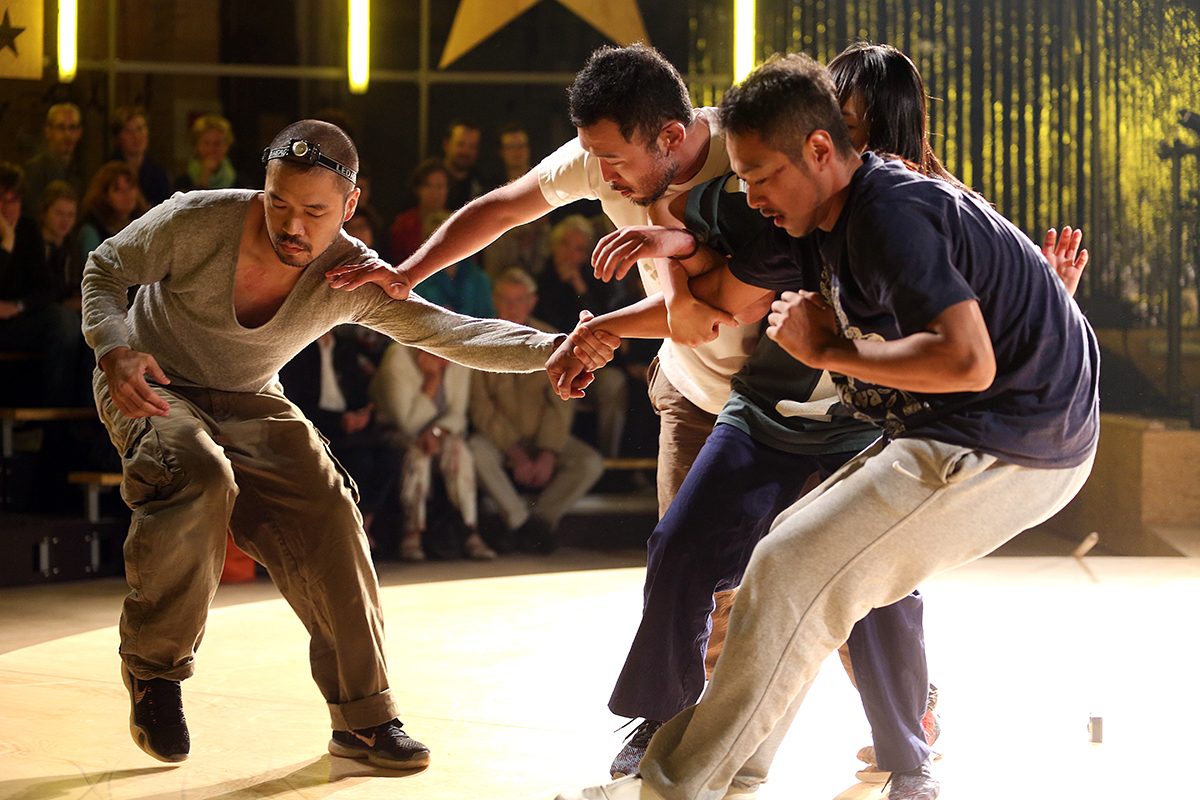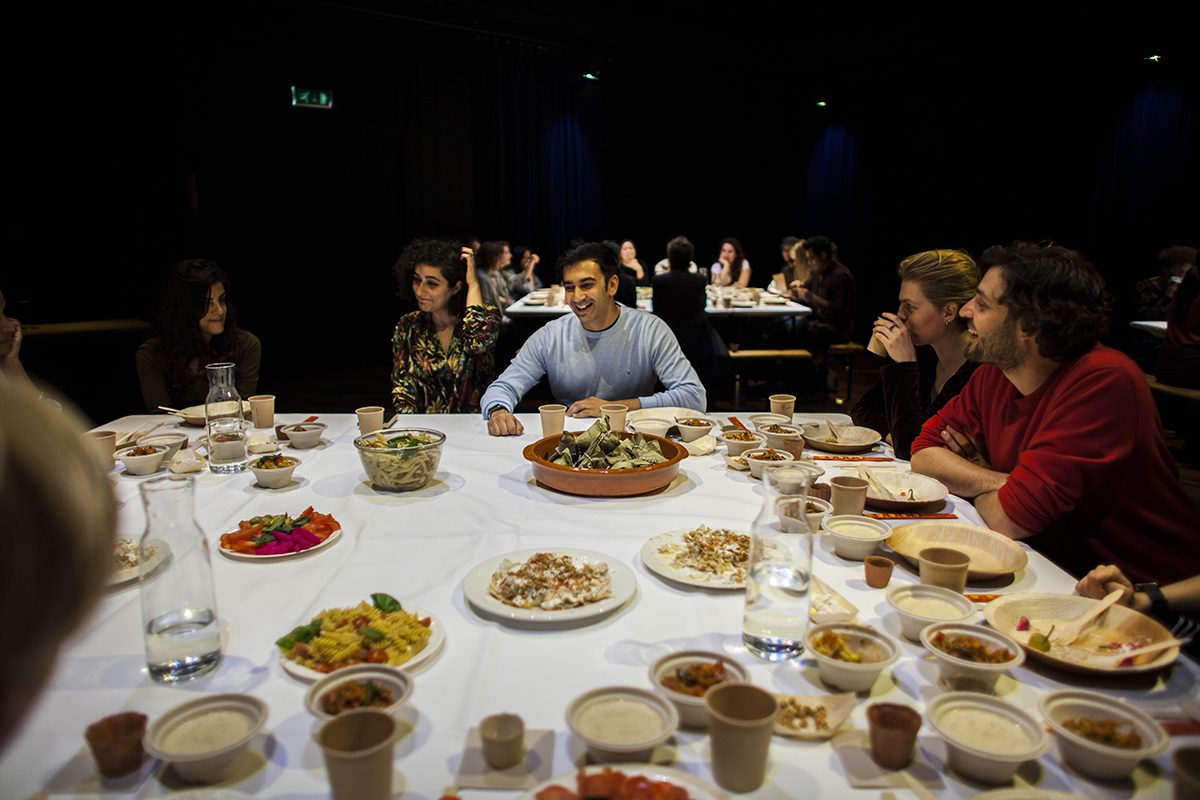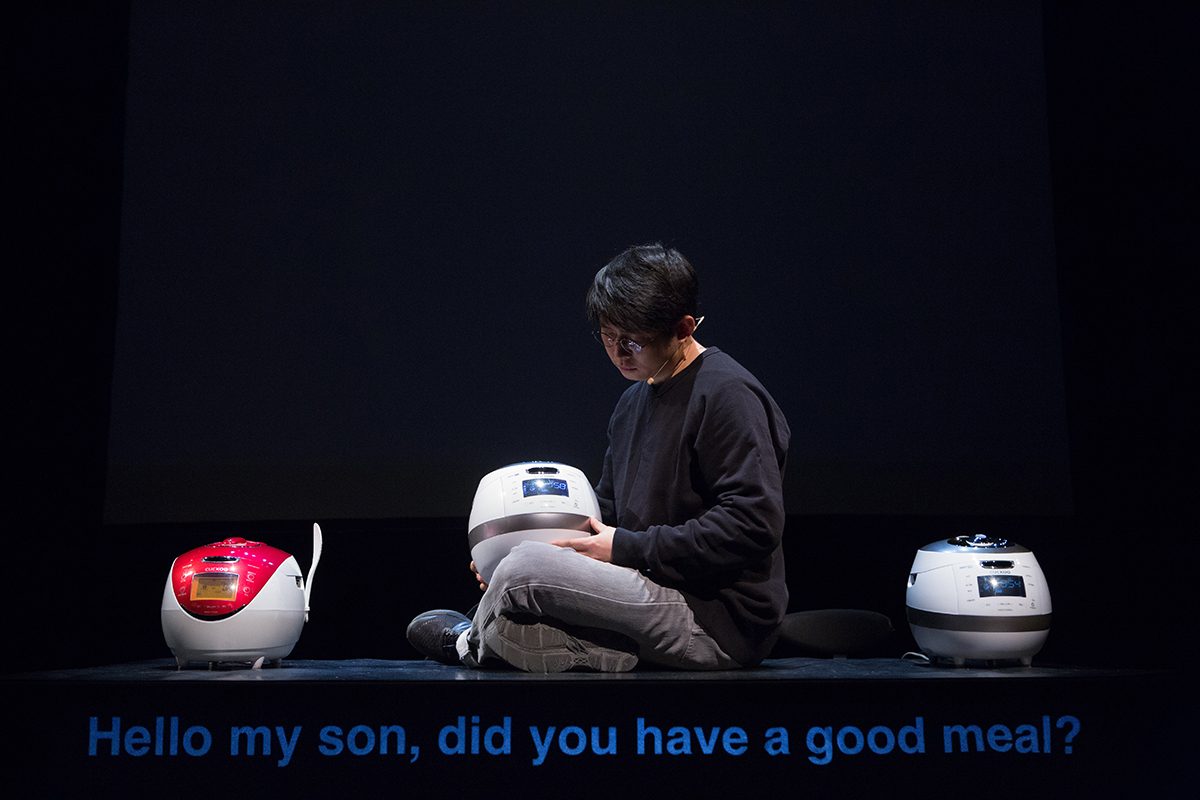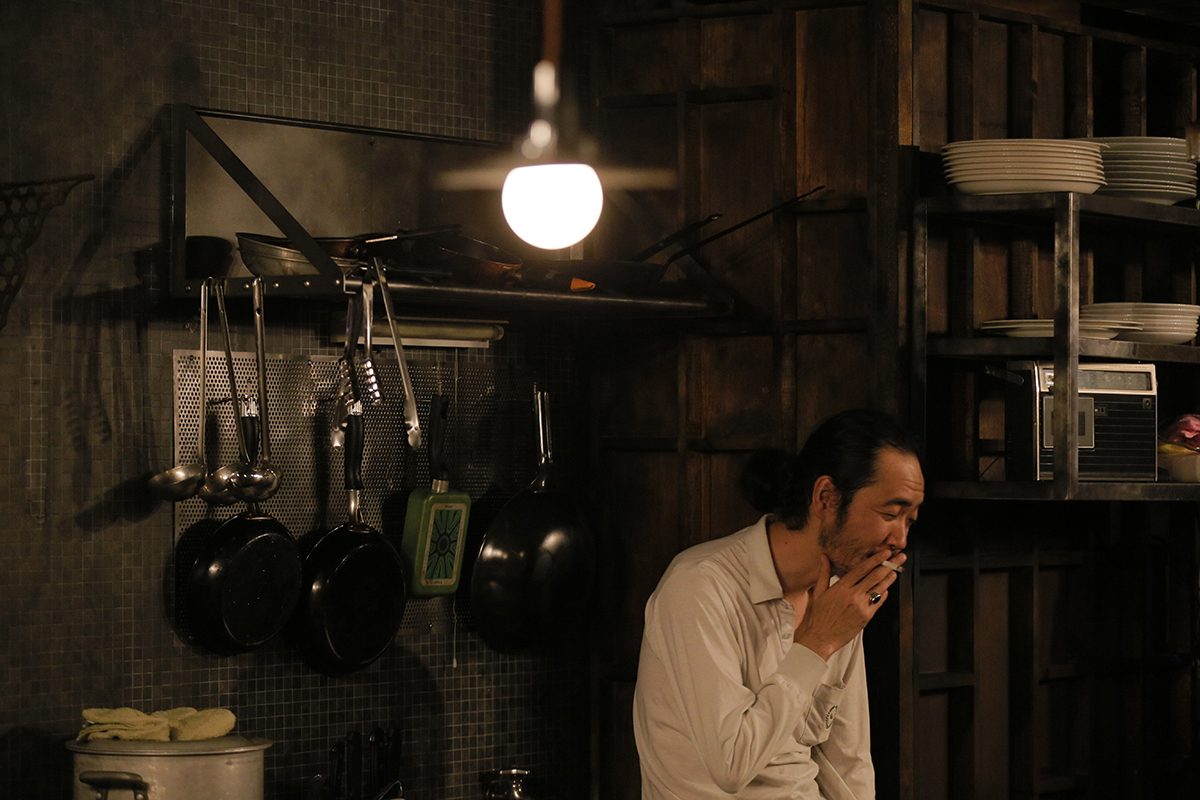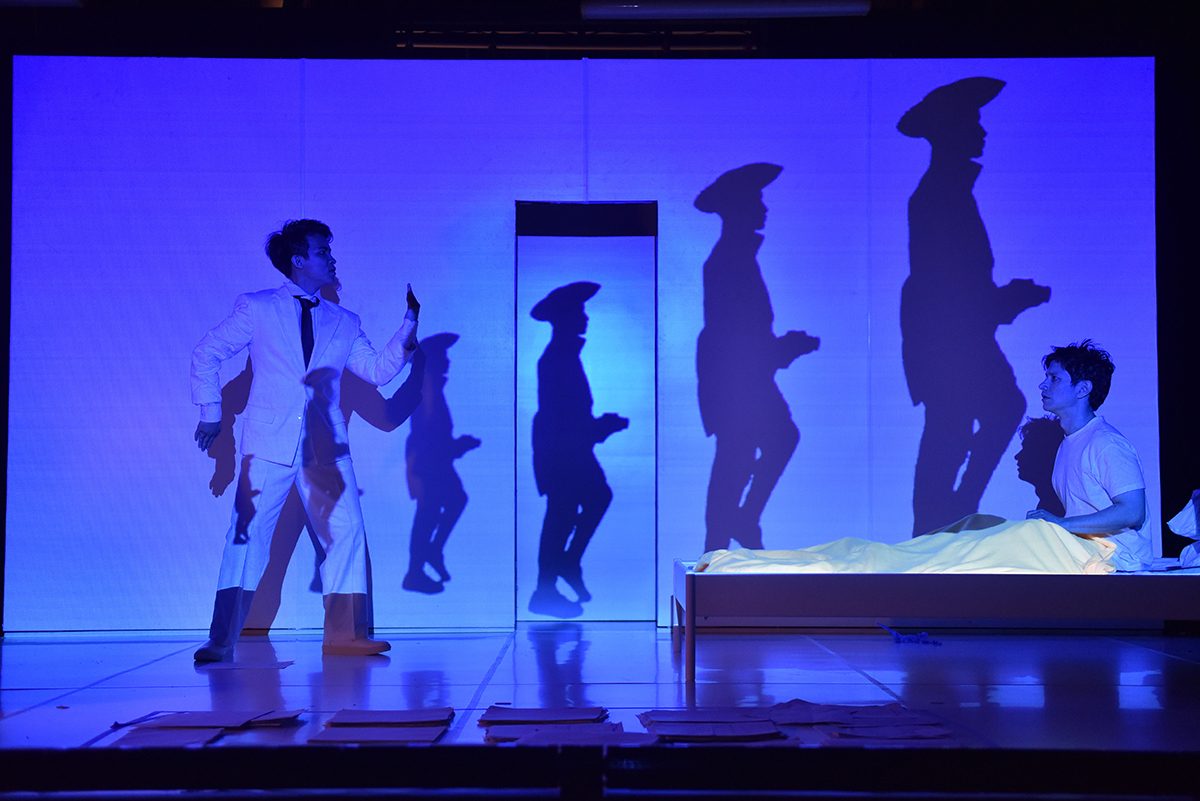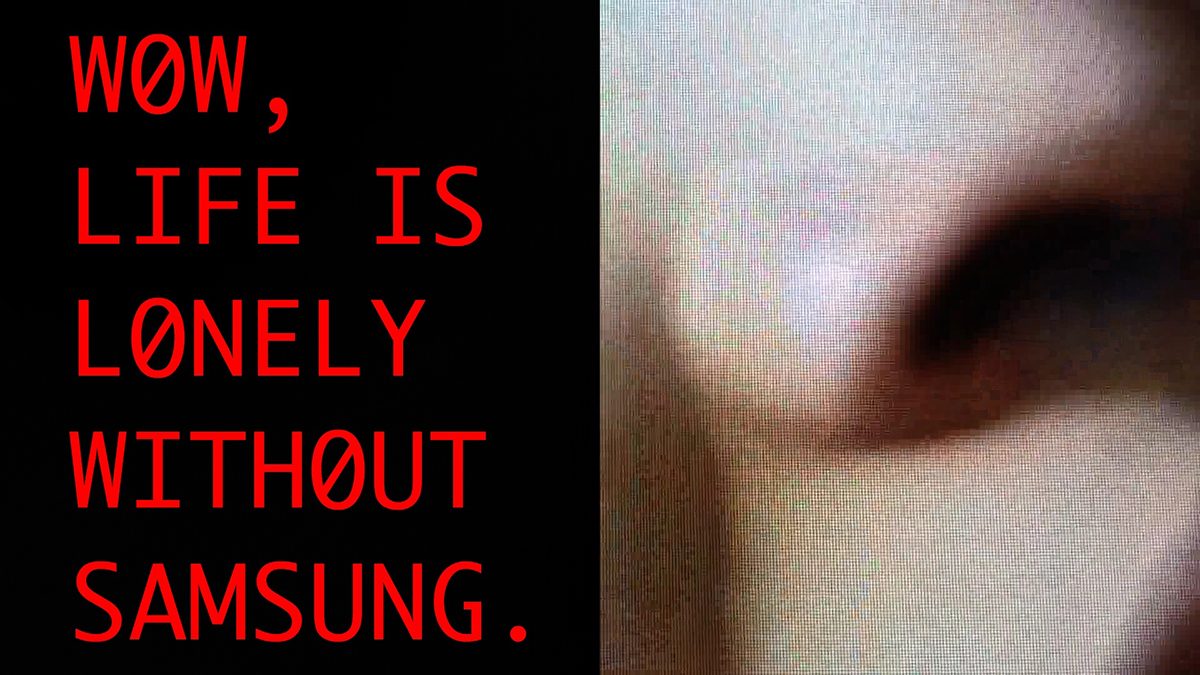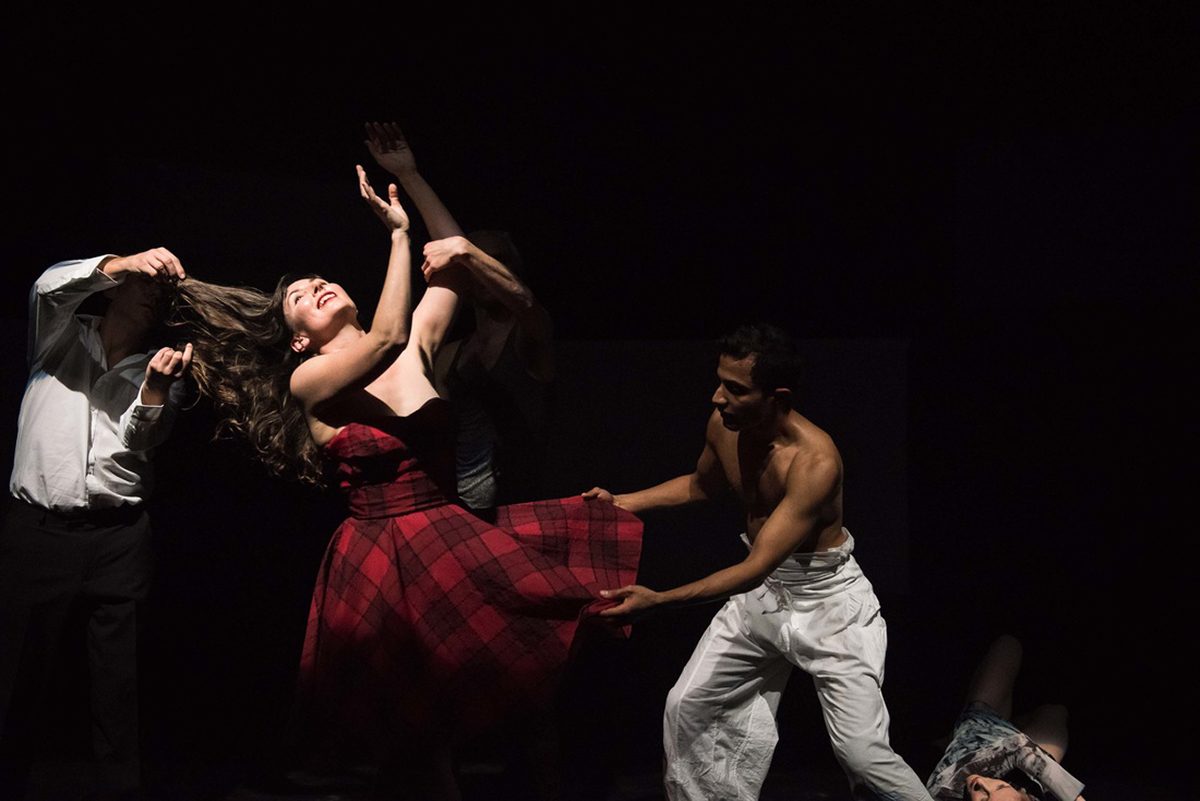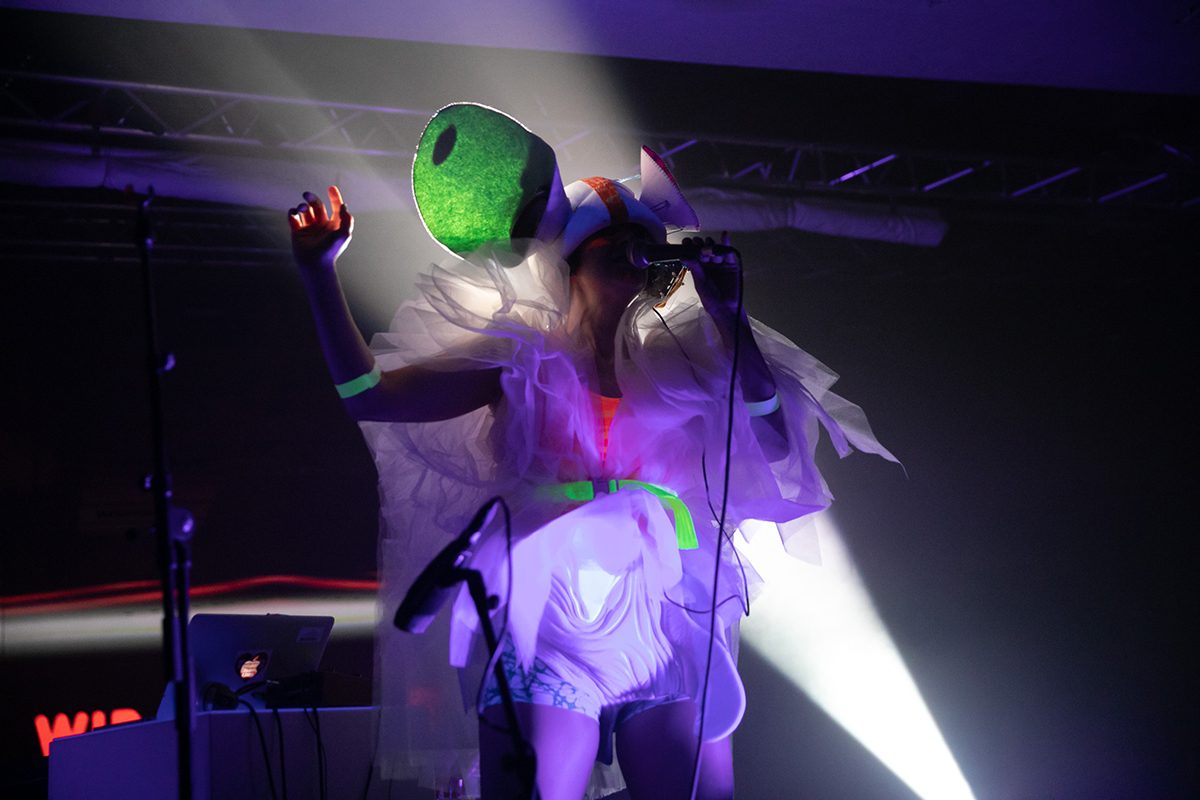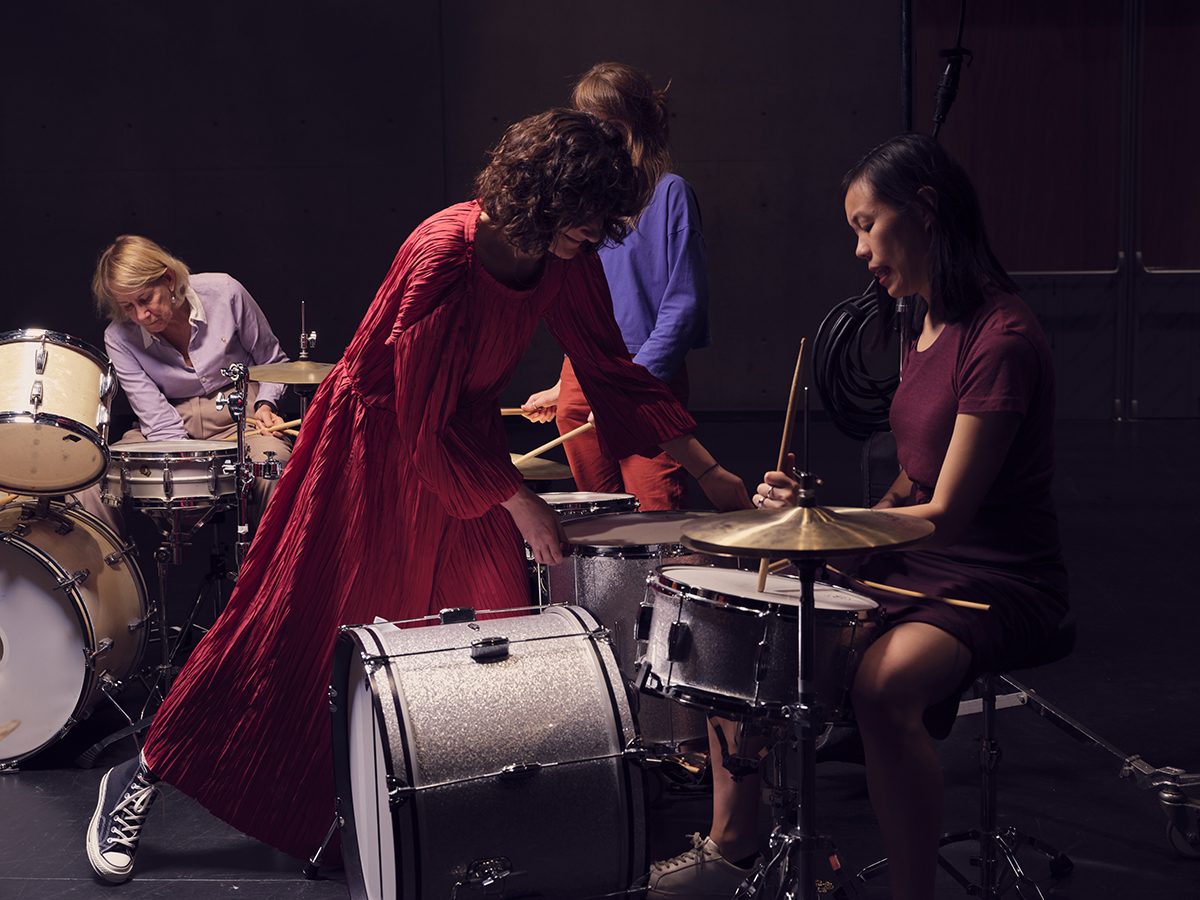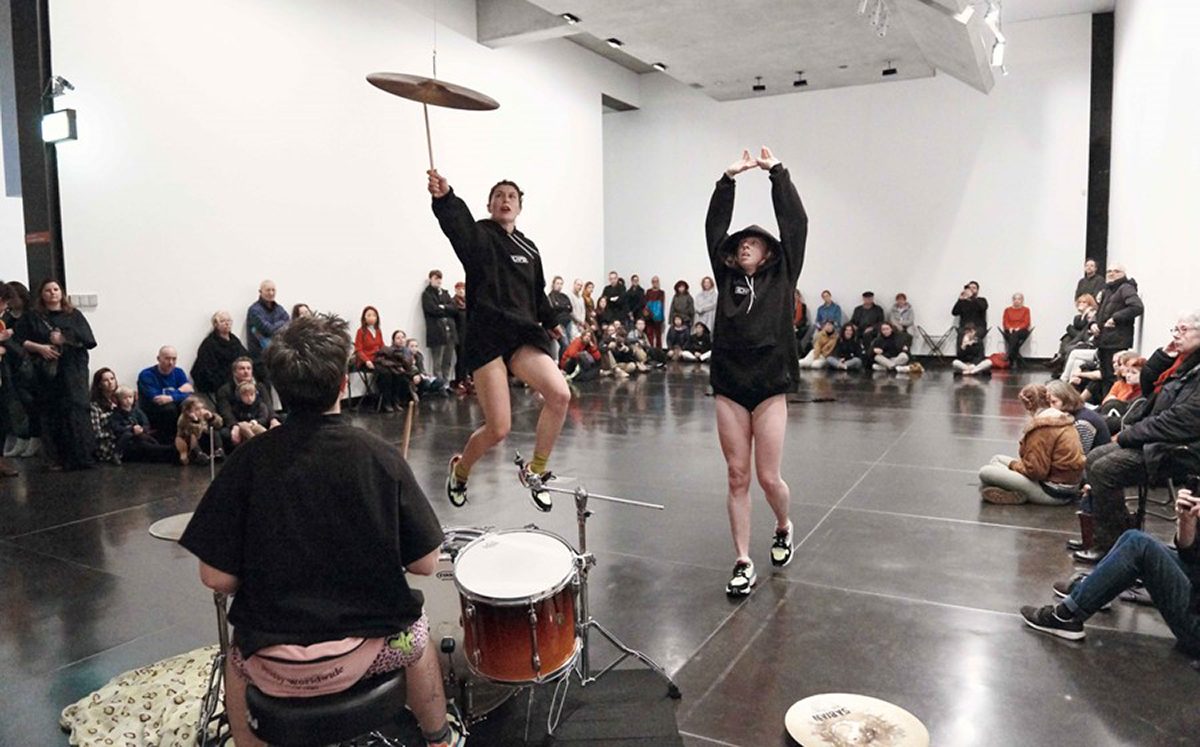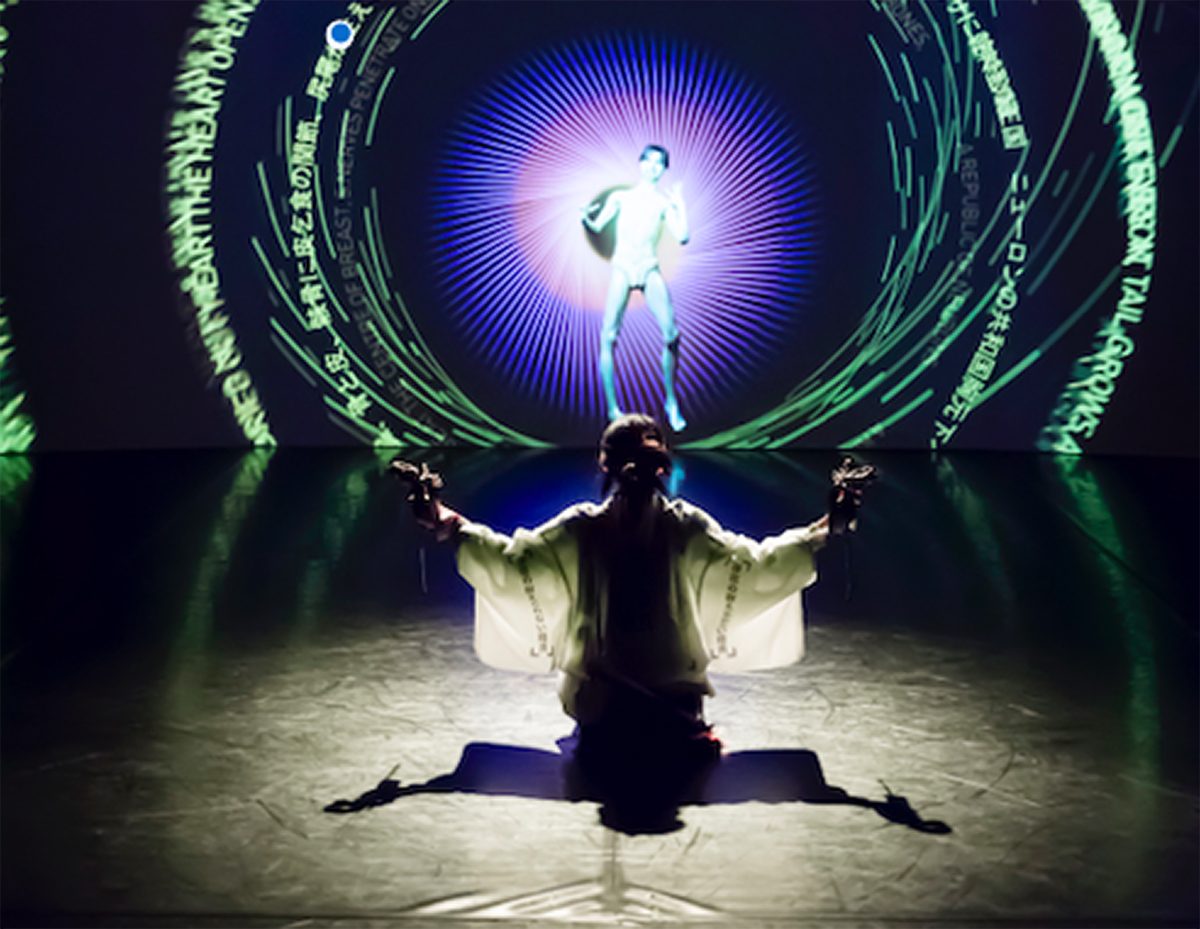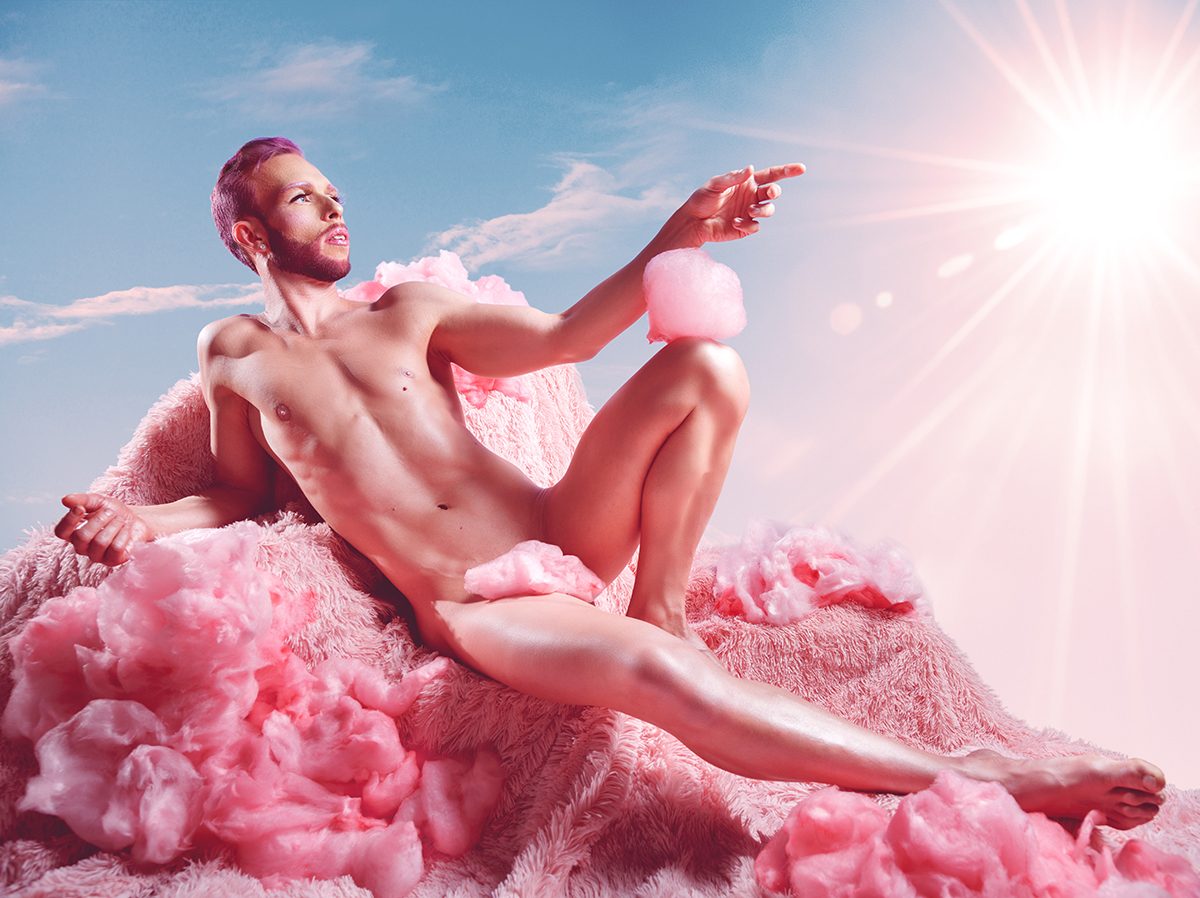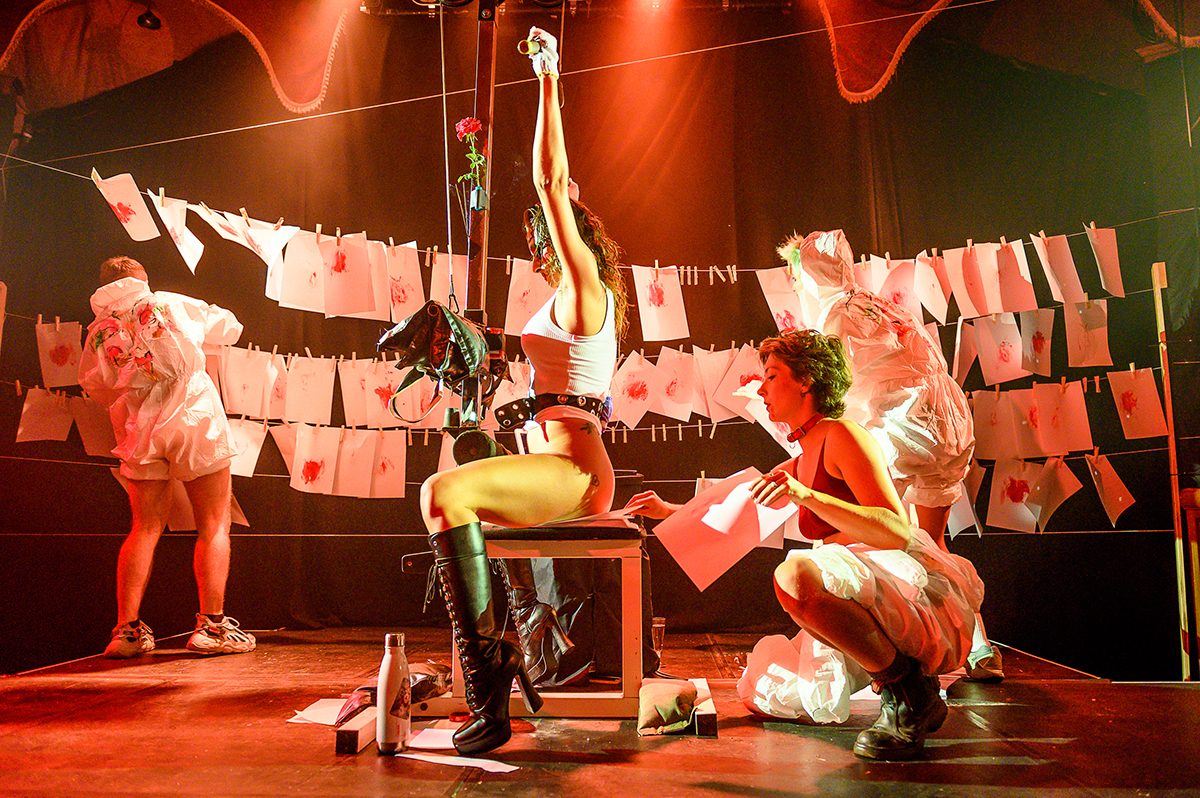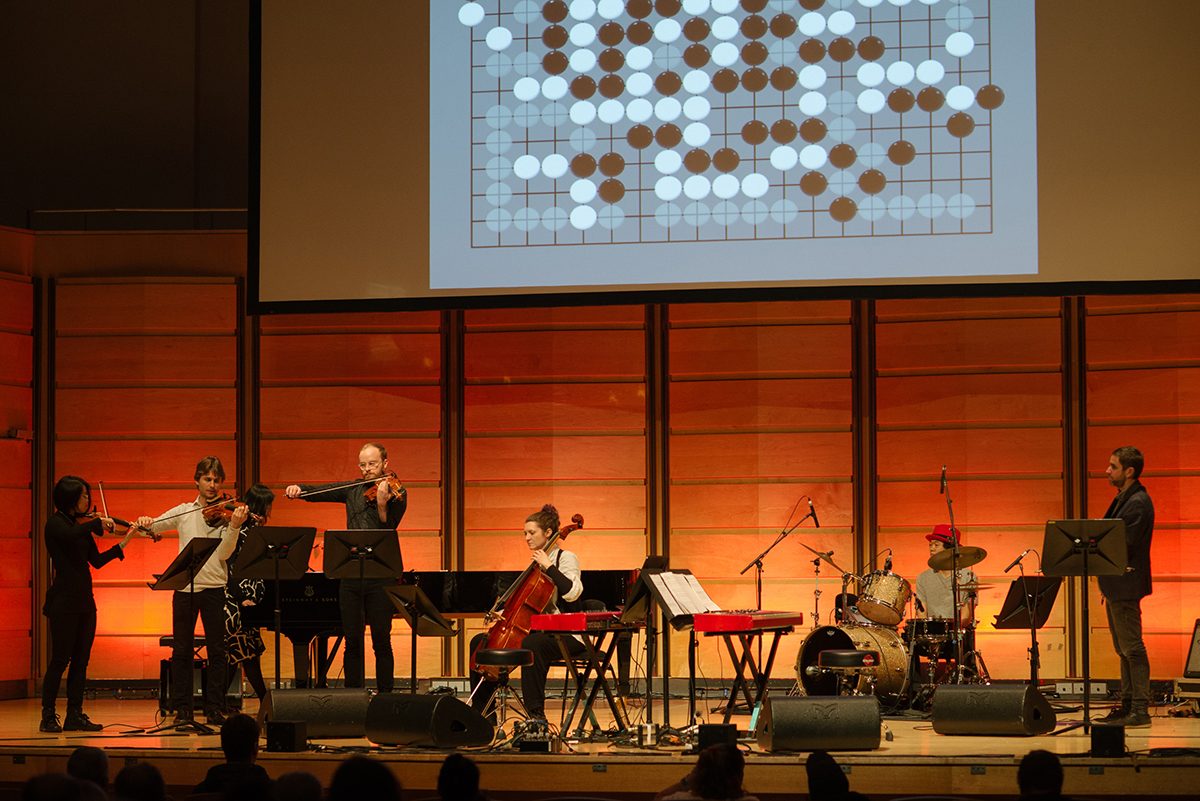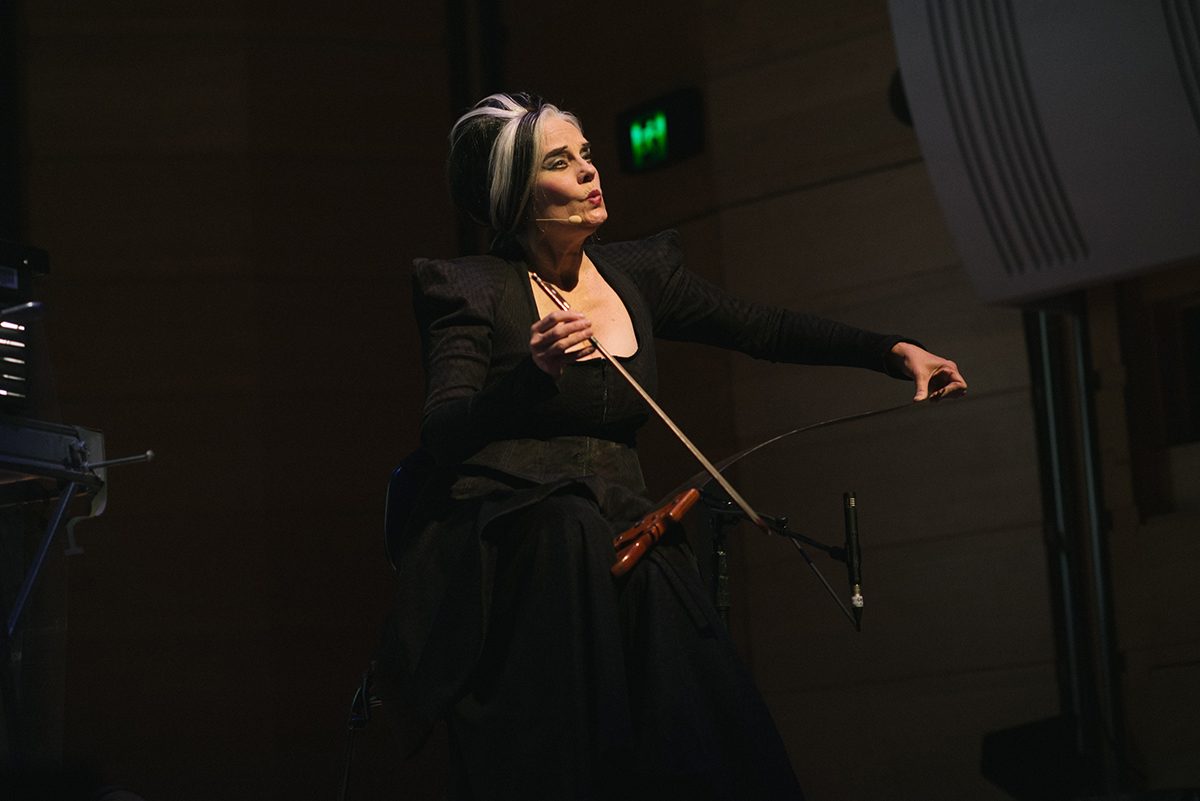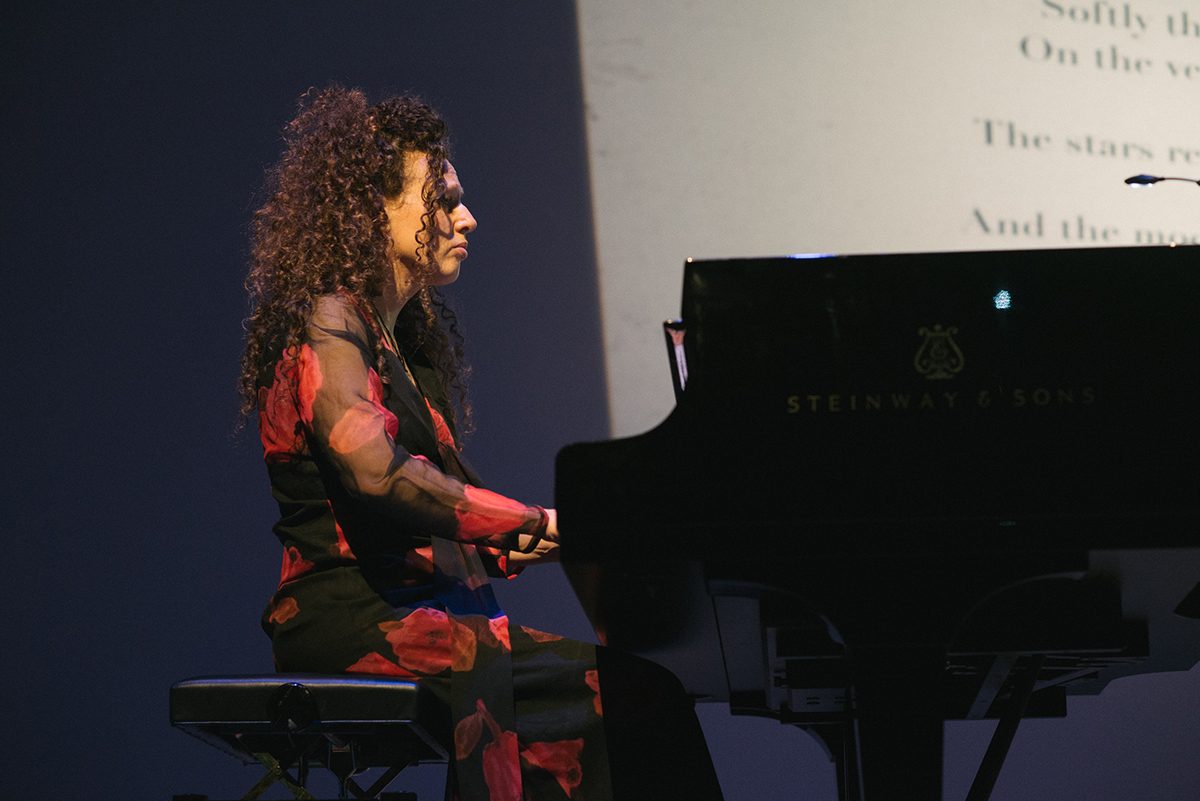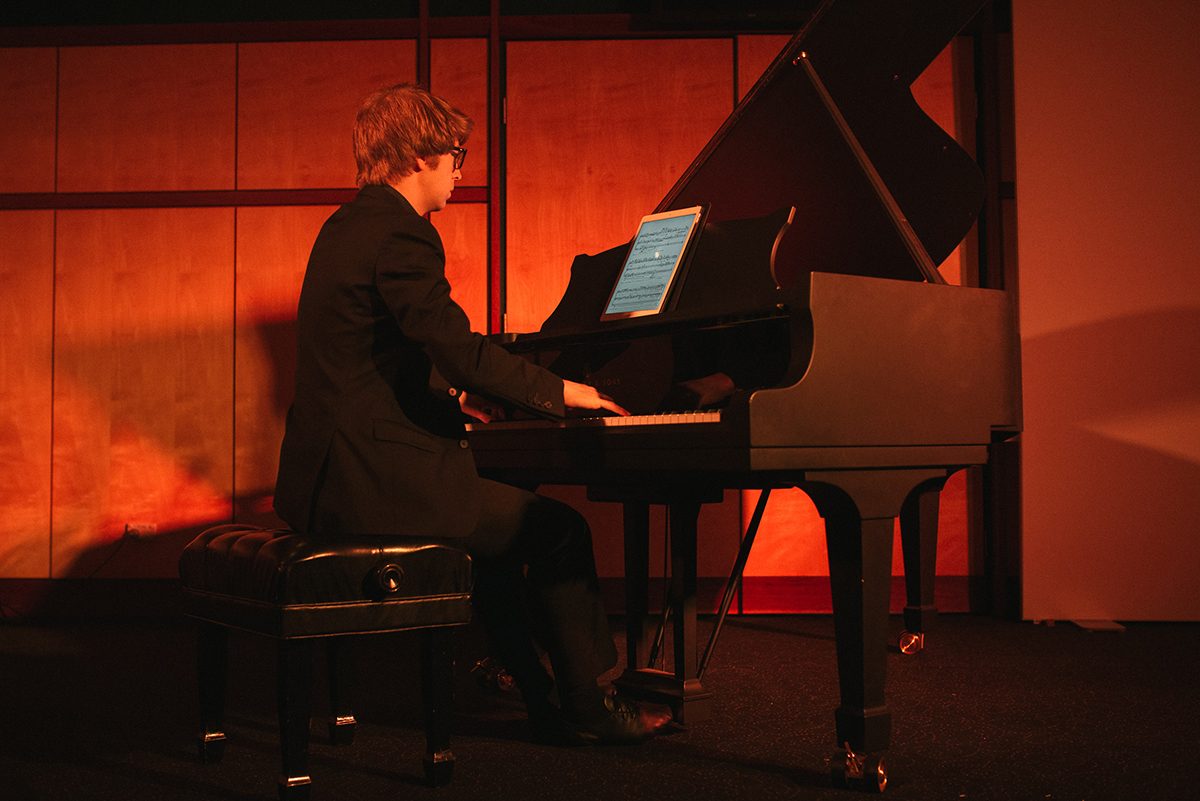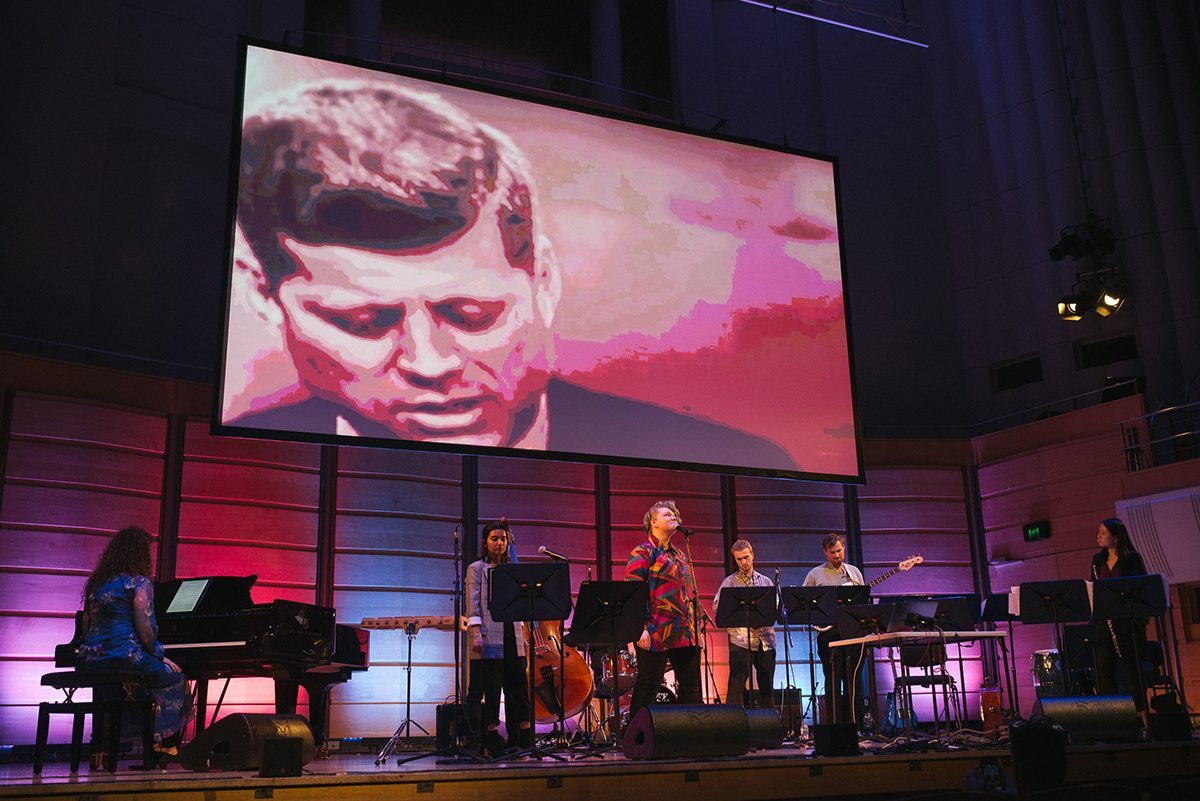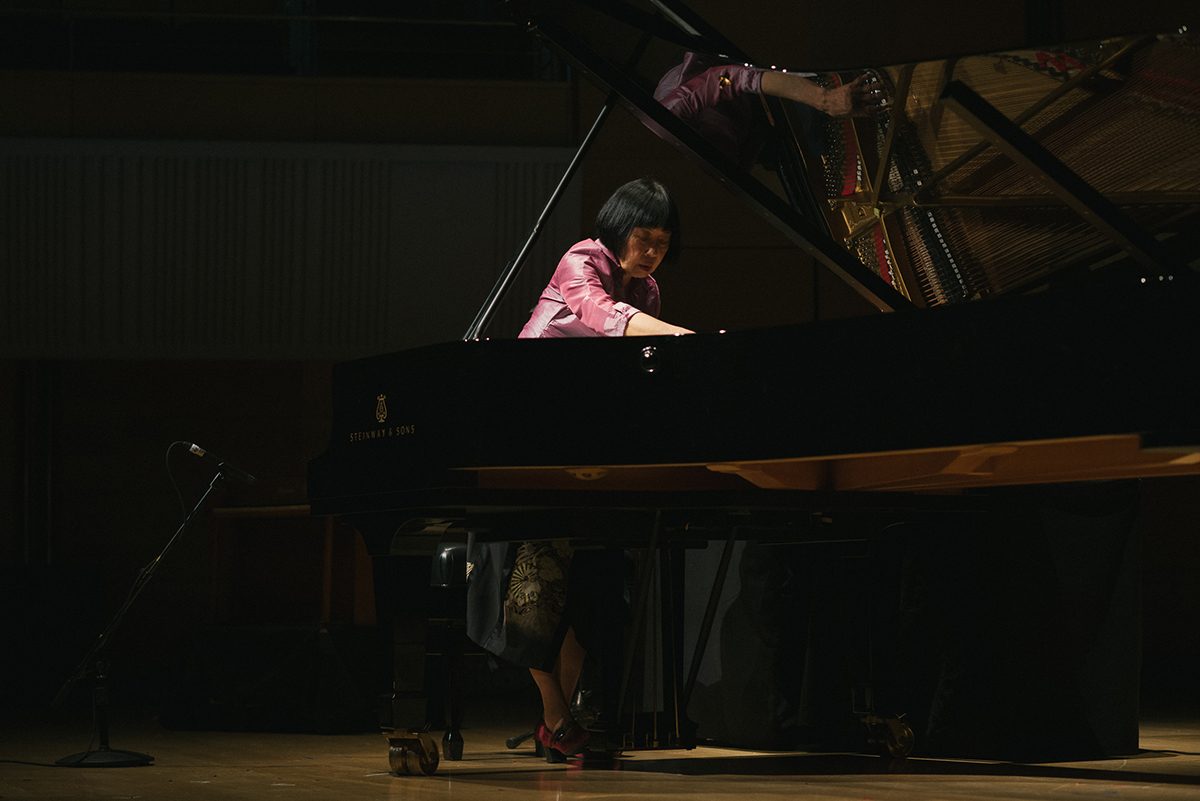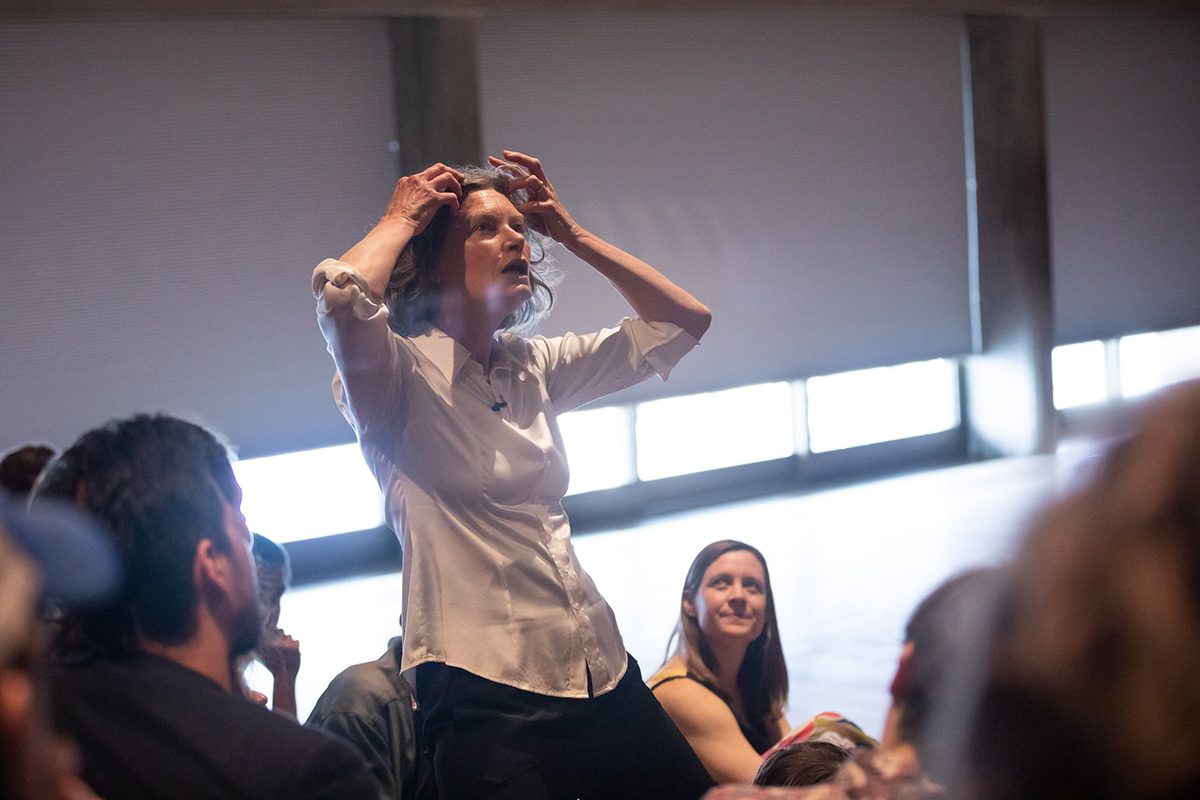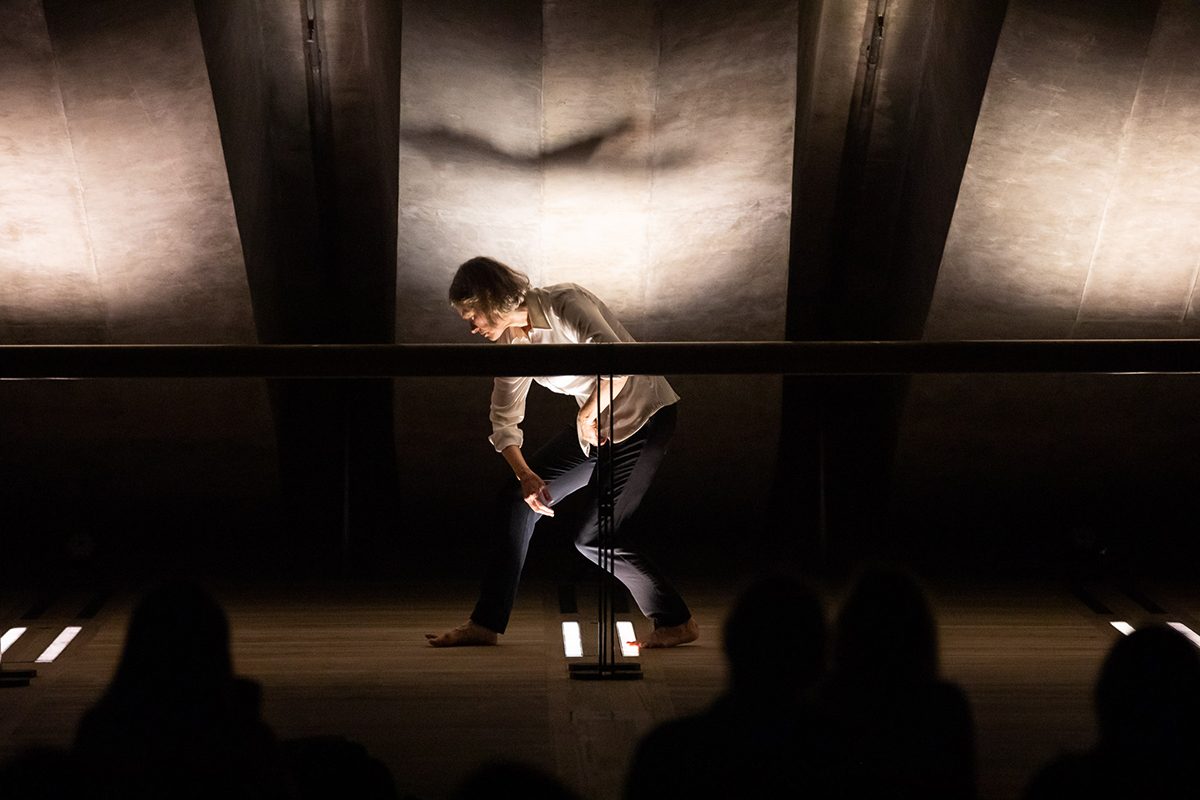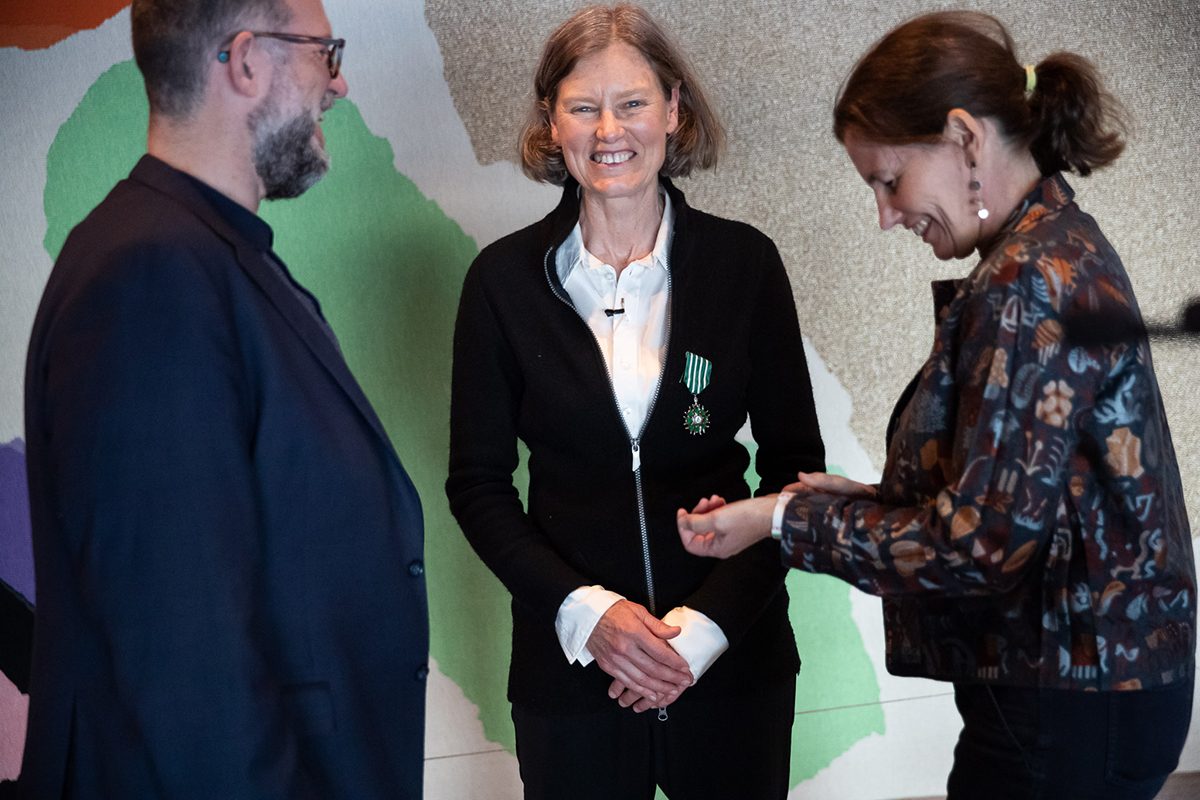October 2019
RealTime Extra. Performance Space’s 2019 Liveworks Festival of Experimental Art and Adelaide Festival Centre’s OzAsia (image above: audience playing bankers in Ontroerend Goed’s £¥€$) both kick off in coming days with programs of rare intensity and invention. We guide you through their programs. We recently saw dancemaker Rosalind Crisp at the Sydney Opera House in a deeply engaging account of connections between the building, the dancer’s body and a struggling Australian environment. For more on sustainability, dancemaker Sue Healey’s Platform Paper eloquently addresses dance ecology through her engagement with film. In September Sydney’s contemporary music audience was generously treated (a mere $35 a ticket) to the gripping 12-hour Extended Play event at City Recital Hall.
If you’re in Sydney, definitely don’t miss The Big Anxiety at UNSW Galleries in Paddington, a superbly curated collection of works and talks that help manage panic and concretely nurture empathy. Some of the standouts are VR works, not least Alex Davies and Michaela Davies’ magical Edge of the Present. It’s against the odds these days, but stay calm. Art helps. Keith & Virginia
–
Top image credit: £¥€$, Ontroerend Goed, photo Thomas Dhanens
From an expansive OzAsia Festival program, his fifth, Artistic Director Joseph Mitchell and I settle on a handful of works that test the limits of performance and intensify audience experience via, variously, food, social gathering and, scarily timely, playing at being global bankers. Some are also indicative of the importance of cross-cultural collaboration—between Belgian and Hong Kong artists in one, and between Australian and Asian artists in two others—making the festival more than a showplace for ground-breaking Asian performance. It’s also a program which allows Mitchell to give expression to his considered curation, bringing back key artists from his previous festivals who have created the terrain on which newer artists he’s presenting this year have found the space to innovate. Intellectually and experientially, OzAsia is much more the sum of its parts.
First up in my conversation with Mitchell is fighting: the raw, seemingly all too risky physical battles expertly executed by the performance artists who comprise Osaka-based Contact Gonzo—‘contact’ from the aikido-influenced Contact Improvisation developed for dance by Steve Paxton in the US in the 70s, and ‘gonzo,’ for crazy. A decade ago I experienced their wrestling, shoving and trepidatious clamberings close-up with a shocked and then thrilled street crowd in Jakarta. At another time, Mitchell, beer in hand, had witnessed them on a skyscraper rooftop in the same city, accompanied by a heavy metal soundtrack.
Why pair Contact Gonzo with Adelaide’s Zephyr Quartet?
Every work Gonzo makes is so wildly different. I didn’t know where to start, so I flew [company founder] Yuya Tsukahara and other members here and said, “I’m just going to walk you round Adelaide for two or three days and introduce you to a few artists. Just tell us which venues you like and the artists you think you’d like to work with, or if you just want to bring one of your existing shows.” They said, “Anything but a [real] ‘venue’ would be great.” They’re in love with the backstage and narrow pathways and how to move people through them. Gonzo loved the ideal of counter-balance with Zephyr string quartet. Because they’ve played with big post-rock groups from Japan, heavy metal bands from Indonesia and noise groups, a string quartet sparked their imagination. And also, my impression of Zephyr is that they’re up for anything. This is a world premiere. In my view it’s contemporary dance, but some people might be more comfortable with the term ‘physical theatre.’ They’re artists who are pushing the boundaries; that’s really all that matters to me.
Let’s talk about other works in your program that push at the edges of form.
Two things. First, I wanted to look at artists who have been really well received over the past four or five years and [ask] how can we continue our audience’s relationship with them. Clearly, artists who are able to have a long-term impact in Australia can only do so because people see their work repeatedly. Secondly, how do we keep evolving the audience’s experience of the performing arts in OzAsia? There are quite a few shows where you won’t find yourself in a traditional theatre. Abhishek Thapar’s Surpassing the Beeline has the audience sitting around three dinner tables with migrants from six countries who have been working all day to prepare their national dishes. It’s a storytelling exchange around sharing a meal. The theme of the work is migration but while so much talk about migration seems to be in negative territory like [the treatment of] refugees, what this work is saying, actually, is that migration is a real part of the human experience. It’s really that simple, but I think we need that right now in a relaxed casual conversation over a meal. If we’re not migrants ourselves, we probably only need to go back one or two generations in our family to discover them.
I see that food also features in the South Korean work Cuckoo.
“Cuckoo” is the main brand of rice cooker in South Korea. Three telerobotic rice cookers talk about the history of South Korea over the last 20 years, particularly in relation to—to be very literal about it—the ‘pressure cooker’ society of that country and the challenges faced as a result of economic pressures and other extremes. Cuckoo starts out as a lecture and evolves into a dialogue between the rice cookers with the work’s maker, Jaha Koo, onstage with them and a big screen behind. The format is almost performance lecture, a form that has become reasonably prominent in the last five or six years.
Judging from performance lectures by Filipino artist Eisa Jocson and South Korea’s Geumhyung Jeong in Performance Space’s 2017 Liveworks, this is a form developing in Asia.
That’s right. I’m open to it if it really challenges the form and Cuckoo does this in a really interesting way. Jaha has a very dry delivery and lets the rice cookers fly with their personalities. There are fascinating insights about South Korean culture and some dark, unexpected turns.
The Belgian company Ontroerend Goed, true to form, will engage their audience directly in the performance. What’s the work’s connection with Asia?
When this show, £¥€$, was created, Ontroerend Goed also rehearsed—with the same director—a Cantonese-speaking company from Hong Kong who were performing in festivals in Hong Kong and Macau. I thought for OzAsia we should get half the cast from each of these companies and bring them together. We’ll basically have half the tables run by the Hong Kong performers and half by the European performers. It’s a wonderfully immersive show, about the most interesting experience I’ve had in the theatre over the past year. The performers are like very neutral facilitators, basically putting the show in your hands.
At the start, you hand over say 10 dollars and they’ll give you 10 million in chips; then you have to come up with the name of your bank. The performers will then guide you through how to run it. All the odds are explained and it’s up to you if you want to roll the dice and gamble to invest and make money. In the centre there’s a World Central Bank. £¥€$ gives you huge insight into the global banking system. What if you’re in control and the odds are in your favour, how do you behave [especially] when you can’t see anything outside the world you’re in? How does the world banking system create narratives for the public which are very different from reality? I didn’t want it to end and thought about it a lot afterwards.
In terms of continuity, another show involving food comes from the company that brought the wonderful The Dark Inn to OzAsia in 2017. It was set in a very strange, remote Japanese regional hotel. In this latest work, The Dark Master, an unlikely person becomes a chef in a little café.
Again, this is really about works that veer off into different performance experiences. The premise is that a young backpacker comes into a restaurant and meets a chef who’s misanthropic but somehow still likes to cook. However, he’s decided he’s going to become a recluse and will instruct the backpacker how to cook via an earpiece; everyone in the audience puts headphones on, the chef disappears and we too hear his instructions. On top of that throughout the show there’s live cooking onstage with all the smells and atmosphere of the kitchen.
A kind of hyperrealism, as in The Dark Inn?
Yes. On top of all of that, there’s a slightly twisted, evolving narrative. Kuro Tanino is an incredible theatre-maker. I thought about programming The Dark Master because I was really keen to make sure, one, that most of the performative experiences had a certain uniqueness and, two, I was trying to find a nice balance in the fifth year of my festivals between a bunch of really new artists and some artists that everyone seems to have really admired before and whose careers we see evolving. The Dark Master fell into both of those categories.
What does this programming balance between established and relatively new artists tell us?
Soon we’ll be in 2020. It just rang a little bell in my mind. There was a really wonderful wave of artists that came through from the late 1990s and into the early 2000s who are still just as prolific and still exploring new ground today. I’m talking about artists like Akram Khan, Nitin Sawhney and Lee Mingwei (all three are in the 2019 OzAsia program) and who hit the global scene in the early 2000s and I think—and this is very much my personal point of view—paved the way for a lot more mainstream programming of multicultural stories drawing upon inter-cultural experience of a melding of heritage and contemporary performance to the point that we’re not even thinking about those things, you’re just watching really good work, which is how it should be.
And then there’s the young generation of artists who’ve really started to fly in the last couple of years, like Kuro Tanino and Miss Revolutionary Idol Berserker. Abhishek Thapar and Jaha Koo are super-hot now in the European and Asian art scenes. There’s Contact Gonzo, Omar Musa, Siro-A and the Australian Thomas Henning (ex-Black Lung) working with radical Malaysian theatre-makers TerryandTheCuz. They’ve all come to the fore but I think they’ve been influenced by the generation of artists who were pushing the boundaries in the early 2000s.
Light, an experimental performance collaboration between Thomas Henning and TerryandTheCuz, has a very particular connection with Adelaide.
They’ve been developing Light over three years. It’s about Captain Francis Light and his son, the British-Malaysian Colonel William Light [the Enlightenment-influenced designer of the layout of Adelaide]. Doing a ton of research, Thomas has found what’s been omitted in their history. Martina Rosalls, Francis’s wife and William’s mother, is only referred to in papers as “half-Portuguese,” a refusal to acknowledge her Asian heritage. There are allusions to her having been a princess in the village she was from, but the marriage ceremony wasn’t recognised by the British. Consequently, William couldn’t access his inheritance and neither could Martina; it was mysteriously taken away. Nowadays, we’re more prepared to question our nation-building history in terms of racism.
OzAsia: visual arts
As usual, the visual arts program, in part in collaboration with local galleries, complements the festival’s performance components, this year featuring notable interdisciplinary artists: Amsterdam-based Indonesian-Australian Fiona Tan and, from Taiwan, Joyce Ho, Su Hui-Yu and New York and Paris-based Lee Mingwei.
From further afield, In Sorry For Real, utilising light boxes and video, French Guyanese-Danish artist Tabita Rezaire has invented ironically telling “virtual apologies” from the West. Seoul-based duo Young-Hae Chang Heavy Industries will present their two Samsung videos, with a third commissioned by OzAsia to complete a Samsung trilogy. RealTime followers will recall Kim Machin introducing their work, with its dextrous text play and propulsive scoring, through her Multi-Disciplinary Art Asia Pacific (MAAP) festivals. Mitchell tells me that the first part of Samsung Loves Us All is about birth, the second midlife and the third, the new work, death. To explain this ‘life cycle,’ he puts the work in context: “In South Korea, you can be born in a Samsung hospital, you can have Samsung phones and get Samsung hardware your whole life and then be buried in a Samsung graveyard. It gives us a bit more insight into the impact of corporations.”
Reading the script of The Glamorous Boys of Tang, an infamous homoerotic 1985 film by Taiwanese director, screenwriter and poet Chui Kang-Chien, the widely acclaimed video artist Su Hui-Yu discovered scenes that hadn’t been realised and decided to make them himself in his own distinctively vivid style and with a slow, revealing pan. Mitchell says that the original “was about the excesses of sexual freedom and liberation, queer identity and revisiting themes from the Tang Dynasty through a part-sexualised lens of the mid-80s. The 15-minute video response, in four-panel, classic fan shape, is an amalgamation of the missing scenes and a re-interpretation of some of the existing ones, acknowledging the original but exploring the cult underground and sexual fantasies and identities of modern-day Taiwan at the same time as looking back to the sexually liberal Tang period. Su speaks about this really well, [asking], ‘Where did sex become so conservative?’” Much of the blame falls on the West. The Glamorous Boys of Tang was Winner of the Visual Arts Award at Taiwan’s 2019 Taishin Arts Awards; Joseph Mitchell was one of the judges. The freely accessible visual arts showings are a must-see part of OzAsia’s program.
You can see more of the 2019 OzAsia Festival program here. It includes Akram Khan, Nitin Sawhney, a large-scale theatre work, The Village, from Taiwan, Vessel, a collaborative dance work from Belgium and Japan, and, Japan again, the riotous Miss Revolutionary Idol Berserker who will pelt you (in a raincoat) with glitter and tofu, plus Malaysian-Australian rapper and poet Omar Musa who will perform his much praised solo reflection on his life and inspirer in Since Ali Died.
If you’re living in eastern or western Australia, you’re curious about Asian contemporary art practices rarely seen here and you’re especially open to the seductions and challenges of innovative performance, it’s time to make your way to Adelaide for a seriously distinctive festival over the next three weeks (and double the pleasure by taking in Australia’s premiere Aboriginal and Torres Strait Islander Art Event, Tarnanthi at the Art Gallery of South Australia).
–
OzAsia Festival, Adelaide, 17 Oct-3 Nov
Top image credit: The Glamorous Boys of Tang video installation, Su Hui-Yu, image courtesy OzAsia 2019
Unusually for a Platform Paper, Sue Healey’s Capturing the Vanishing: A Choreographer and Film, tells a fascinating life story. If not quite as personal as that might suggest, the essay is nonetheless an intimate tale of the organic, if sometimes chancy, evolution of an artist seeking unfettered creativity and career sustainability in the face of the predations of ephemerality. That’s a condition inherent to all creative acts but exacerbated in independent dance in Australia by cruelly short performance seasons, limited touring opportunities, declining arts funding and consequent invisibility and absence of agency: “The consequences are diminishing diversity and the reduction of new voices, as well as choreographic careers that do not find full potential.”
A multiple award-winning choreographer, Healey hybridised herself by becoming a filmmaker, finding new agency in translating stage performances into film, creating standalone dance films and installations and seeking out new niches, with notable success in Asia. Healey has not only strengthened the durability of her practice but in eloquent portrait series has generously preserved the creativity and legacies of fellow and elder practitioners. In doing so she has deftly managed the ephemerality anxiety that has driven her to adapt and which fuels this passionate essay, in which she asks, “How can film capture the visceral organic reality of live performance and take us beyond the vanishing point?”
Healey briskly evokes her emergence as dancer and choreographer prior to her filmmaking commencing with a 1980s New Zealand childhood (her father’s Super 8 films, her former ballerina mother’s magical dancing in the family home), finding the dance—not ballet— that works for her, training at Melbourne’s VCA, performing with Nanette Hassel’s Danceworks (to frustratingly conservative responses), in the studio with Merce Cunningham and other luminaries for several inspiring years in New York, returning to newly invigorated Melbourne dance and becoming director of Vis-à-Vis Dance in Canberra (1993–95), until a savage funding cut propelled her into the life of an independent choreographer.
The account of her subsequent career across the balance of the essay entwines Healey’s evolving attraction to filmmaking and her corresponding adaptation, via film, to a rapidly mutating contemporary dance world of cross-artform and new media-driven ventures, with dance more than any other artform leading the way in the 90s. Healey had sensed the change already in the dance and visual arts and experimental films of the American post-moderns in the 80s: “Meredith Monk, Trisha Brown, Steve Paxton and Yvonne Rainer. This made sense to me, as did the pioneering experimental films of Maya Deren, the New Zealander Len Lye and Merce Cunningham with Charles Atlas. My interest was there, I just didn’t know how I could achieve it.”
What’s particularly interesting in Healey’s evolution as dance filmmaker is its phenomenological dimension: her coming to precisely understand her engagement with movement, learning the value of new visual perspectives, putting herself behind the camera, sensing the passage of choreography to film as ‘translation,’ discovering editing as a form of choreography, learning what film can reveal and the stage cannot, and understanding that her filmmaking is a whole-body creative experience.
Healey’s connection with film began in the early 1990s working with experimental filmmaker Louise Curham who drew attention to both detail “at a deeper level” and framing: “I realised as a choreographer that I was more concerned with movement, my eye always moved quickly to the next shape rather than focusing on visual detail.” A workshop in New York with renowned American lighting designer Jennifer Tipton, in which “the choreographers had to design lighting states for the designers, who then had to choreograph and perform within our lighting,” taught Healey “the strategy of coming at creative ideas from a reverse perspective and realising the importance of widening my scope into other forms—a pivotal ‘aha’ moment for me.”
Another reversal of perspective, when a “constant switching of focus between dance and film became a necessary part of my process,” emerged from Microdance in 1996. In enlightened times by today’s standards, Healey and Curham were one of four teams granted $100,000 each by an Australia Council, Australian Film Commission and the ABC initiative: “Making Slipped was a watershed moment. I realised that to understand the process more fully, I would have to move to the other side of the camera. I began to make short films in conjunction with every live work I made, simply by using my own small camera. This way I was able to explore in the studio with the dancers before bringing in a professional cinematographer for the actual shoot.” In a crucial development, Healey’s collaboration with cinematographers in 2002-13 “also extended to dancers Shona Erskine, Lisa Griffiths, Nalina Wait and later Rachelle Hickson,” who, rather than being ‘choreographed on’, “quickly developed an ability to understand the dimensions of the frame from a dancer’s perspective, and how the camera saw the body in space, and choreographed themselves efficiently into a dialogue with the camera.”
Healey writes intriguingly of the act of dance filmmaking: “When it is working well, I enter into a non-verbal state akin to seeing with my whole body rather than just my eyes—of conjuring up the ‘right’ image in the ‘right’ place at the ‘right’ time, and always underpinned by the question—does it move me? Physically, emotionally and intellectually?” However, she also came to realise that film editors “held the choreographic power. I needed to become an editor myself and master this skill…”
Healey’s gradual transformation into consummate director and editor, in team with cinematographer, dancers and composer, has confirmed her “realisation that the screen could be a specific site” for dance, no mere substitute for the stage.
From 2000 to 2012 Healey and many other dance filmmakers had been supported in a significant niche, the Sydney-based Reeldance International Dance on Screen Festival, which encouraged innovation and provided a platform with international connections: “But funds were eventually cut and Reeldance ceased operations in 2012, just as many of us were ready to go further. The void left in the wake of this closure is still apparent today.”
in the current decade Healey has radically diversified the techniques, forms and scale of her creations. En route (2017) was a commissioned work for Wynscreen, a 22-metre wide by three-metre high LED screen in Sydney’s Wynyard train station. Virtuosi (2013), a feature-length “creative documentary” about dancers and place was created “akin to making dance—a situation is framed and investigations are undertaken through improvisation—in a sense, a controlled uncontrollability.” The Golds (2014), about notable dancers 60-90 years of age, offered revived visibility and creative opportunity. “These documentary films opened many doors for me internationally, screening in over fifty cities around the world and even subtitled into different languages: Spanish, Portuguese, Cantonese and Mandarin.”
In her on-going ‘portraiture’ series, On View (2013-present), Healey has further pursued a phenomenological preoccupation: “dancers are intrinsically viewed in the course of their work, and they also see the world in a particular way. The idea of ‘seeing and being seen’ is embedded in the work, setting up an intimate and dynamic agency between the observed and the observer.” Having worked across Asia since the 1990s, Healey has extended On View into the region, to climax in 2020 with a production produced by West Kowloon Cultural District (Hong Kong), Aichi Arts Centre (Japan) and Performance Space (Sydney) which will then tour Asia and Sydney.
Healey says of the project that it “breaks the idea that an Australian independent artist must work at a small scale. It has given my work a visibility and viability beyond anything I have ever experienced before. I am also cognisant of the fact that without the interdisciplinary nature of this project, it simply would not have happened.” This acknowledgement underlines the organic evolution of Healey’s 30-year career, one utterly contemporaneous with a great shift in art-making in general and not least in dance, in which she had been both participant and generator.
Cognisant of the struggles ahead of her, her peers and especially a younger generation of artists, Healey concludes her essay with three necessary provocations, one urging equitable government support for independent dance artists, another encouraging debate about the relevance of dance in order to create a vision for sustainability, and this: “Dance must extend its boundaries without losing sight of its own intrinsic qualities as a discipline.” It’s a reminder that however far Sue Healey has taken her practice to the screen as a legitimate site for dance, the filmmaker is always first a choreographer—at one with her dance and screen collaborators.
Young artists, in particular, will value Capturing the Vanishing for its generous, engagingly crafted account of the challenges and breakthroughs involved in sustaining and expanding a career in dance. Emerging and established choreographers will find encouragement to boldly make dance in new ways by reaching out beyond their immediate discipline; Healey cites two younger artists already on this trajectory. As well, the many links to excerpts from Healey’s films that can be activated in the PDF version of the essay make for exciting reading, heightening the sense that Sue Healey has held the vanishing, of dance and career, firmly in check.
You’ll find more about Sue Healey on her extensive website and in RealTime. She is also one of the subjects of the book Bodies of Thought: 12 Australian Choreographers (Wakefield Press-RealTime, 2014).
You can purchase a hard copy or PDF of Capturing the Vanishing here.
For more on dance and editing from a dance filmmaker perspective see Anna Dzenis’ “Editing: beyond intuition,” a review of Karen Pearlman’s Cutting Rhythms: Shaping the Film Edit (Focal Press, Burlington US, Oxford UK, 2009).
–
Platform Papers, No 60, Sue Healey, Capturing the Vanishing: A Choreographer and Film, Currency House, Sydney, August, 2019
Top image credit: On View: Sue Healey (right) and crew on Japan shoot, Nagoya, photo Hatori Naoshi
In the introductory note to his program for an eagerly anticipated 2019 Liveworks Festival of Experimental Art, Performance Space Artistic Director Jeff Khan highlights two themes. First is “Feminist Sound featuring women and non-binary artists who champion the intersection of sound art, experimental music and performance,” and the second, with ample overlap with the first, is Culture Disruptors—makers of work arising from lives in which there is no divide between the personal and the political when it comes to body, race, gender and regional politics—as in New Zealander John Vea’s If I pick your fruit, will you put mine back, an account of the lives of exploited Pacific workers in Australia and across the region.
Instrumental liberation
The Feminist Sound theme will manifest in an array of fascinating forms—first via instruments. For the premiere of A continuous self-vibrating region of intensities, exploratory musician Gail Priest and designer Thomas Burless have crafted intriguing bespoke devices that will be activated by the voices of Priest and the powerful improvisatory artistry of Carolyn Connors and Sony Holowell. Vibrations from the singing will trigger visual realisations of the sound, a phenomenon revealed in the 19th century by the invention of the Eidophone by Welsh singer, songwriter and scientist Margaret Watts Hughes.
From the US, in I’ll be your body instrument, design and fashion-driven cult feminist pop group Chicks on Speed, founded in 1997, will be expanding their performativity via Objektinstruments which include suits that trigger audio and video, hats with speakers and wireless stilettos.
Drums feature dramatically in two works. In Other Tempo, interdisciplinary artist Lauren Brincat (with percussionist Bree Van Reyk for the 2015 Liveworks she marshalled the NSW Police Band into a stirring art ensemble in Social Dance) will transform a group of leading female drummers—including Alyx Denninson and Lindy Morrison on modified kits and prompted by the artist’s visual scores—into a living art work in a series of free performances in the vast Carriageworks public space.
In Double Double, two drummers—media artist Tina Havelock Stevens (Liveworks 2016) and musician Evelyn Ida Morris—partner leading Melbourne dancer-choreographers Jo Lloyd and Deanne Butterworth for an acclaimed two-hour, open-ended exchange for an audience free to shift its perspectives on the aural and visual action.
There’s more to be heard from the human instrument plus further prosthetics for making sound art in Liquid Architecture’s Tricks of the Mouth. Playing for two hours each night across the Liveworks season, it features strong representation of female artists focussing on “linguistic re-coding, verbalism, chatter, translation, transposition, impersonation, and noise” and includes among others Indonesian punk coder and designer Natasha Tontey, legendary Japanese musician Phew, Chinese Singaporean artist Zou Zhao, Australian overtone singer Sage Pbbbt and Sydney sound artist Alexandra Spence.
The talks component of Liveworks will include Feminist Sound Technologies, a keynote address as performance lecture by Chicks on Speed about their newest “body-centric” objektinstruments, and Shaping Sound, a conversation between Gail Priest, Lauren Brincat and Alex Leslie Murray (Chicks on Speed) about their practices and “what it means to create collaborative work that spans sound, installation and performance.”
Ghost who disrupts
The second theme Jeff Khan identifies in his introduction is Cultural Disruptors. Tatsumi Hijikata’s invention of Butoh in the late 1950s erupted in Japan and spread around the globe and its influence is still felt. Singaporean director and curator (Liveworks 2016) Choy Ka Fai’s Unbearable Darkness, described as “an uncanny cybernetic dance experiment,” “investigates the choreographic process of a ghost through live dance, motion capture technology, digital avatars and a spirit medium. As part of developing the work, Ka Fai visited an itako, or blind medium, on Mt Osore in Northern Japan and invoked the spirit of Tatsumi Hijikata.”
In 2013, Takao Kawaguchi controversially ‘resurrected’ the spirit of Kazuo Ohno (who emerged shortly after Hijikata), copying his “dance of soul” from video tapes and subsequently touring the world in About Kazuo Ohno, including Melbourne’s AsiaTOPA in 2017. In the West, elder performance artists, like Marina Abramovic, have delegated their works to younger practitioners, without mystical resonance (to date); there is perhaps a shared sense of looking back in order to move forward, or as the Liveworks program puts it, “questioning [Butoh’s] appropriation in Western culture while searching for a new choreographic language for the Asian body.” Hijikata and Ohno, though, were skilled absorbers of Western literature, music and dance; is Butoh an innocent artefact? I’m really intrigued by Choy Ka Fai’s project, its bringing together video of Hijikata and a dancer wired as one with him. I’m curious too about the ‘unbearable’ in the title; Hijikata titled his performance ankoku butō—“dance of darkness.” Doubtless the eloquent Choy Ka Fai will have answers in his keynote lecture, How does a ghost choreograph?
Dance as resistance & assertion
Vicki Van Hout’s plenty serious TALK TALK is wonderfully disruptive, challenging dance to meet equally, as it too rarely does, the demands of both the personal and the political. As I wrote in my review of the 2018 premiere, “With stand-up comedy verve, skilful acting and multimedia dexterity, engrossing, illuminating dance, an eerily spare music score (in an era of sonic lambast in dance) and, above it all, the artist’s glowing woven-grass sculpture-cum-screen suspended centre-stage, plenty serious TALK TALK is a wonder, revealing the complex entwining and unravelling of race, craft and culture in one fraught soul querying her courage to persist against the odds.”
Another Indigenous dancemaker, Melbourne’s Joel Bray looks set to wow us with his much acclaimed Daddy, a sad-funny queer assertion of the inseparability of the personal and the political when it comes to love, executed with a deeply ironical if very literal application of the sugar with which Western civilisation coats its colonising brutality; to say more would give too much away.
Add Double Double, which I’ve already mentioned, and you have four must-see dance works, all displaying contempoprary dance’s ongoing, expansive engagement with ideas and other forms.
Out of the underground
Another disruptor is Betty Grumble (Emma Maye Gibson), whose The Unshame Machine makes an art of “pussy printing” in a “deep squat disco” setting. Gibson, who emerged into prominence from the queer underground cabaret scene this decade, and has appeared on Q&A and this year at Griffin Theatre, describes Grumble as, “This freakish exhibitionist who gives it all yet seems only to be seeking something everyone needs: understanding and acceptance.” She told the Guardian, “I want to tell stories ferociously, from my guts, and the body was an immediate site for that excavation.”
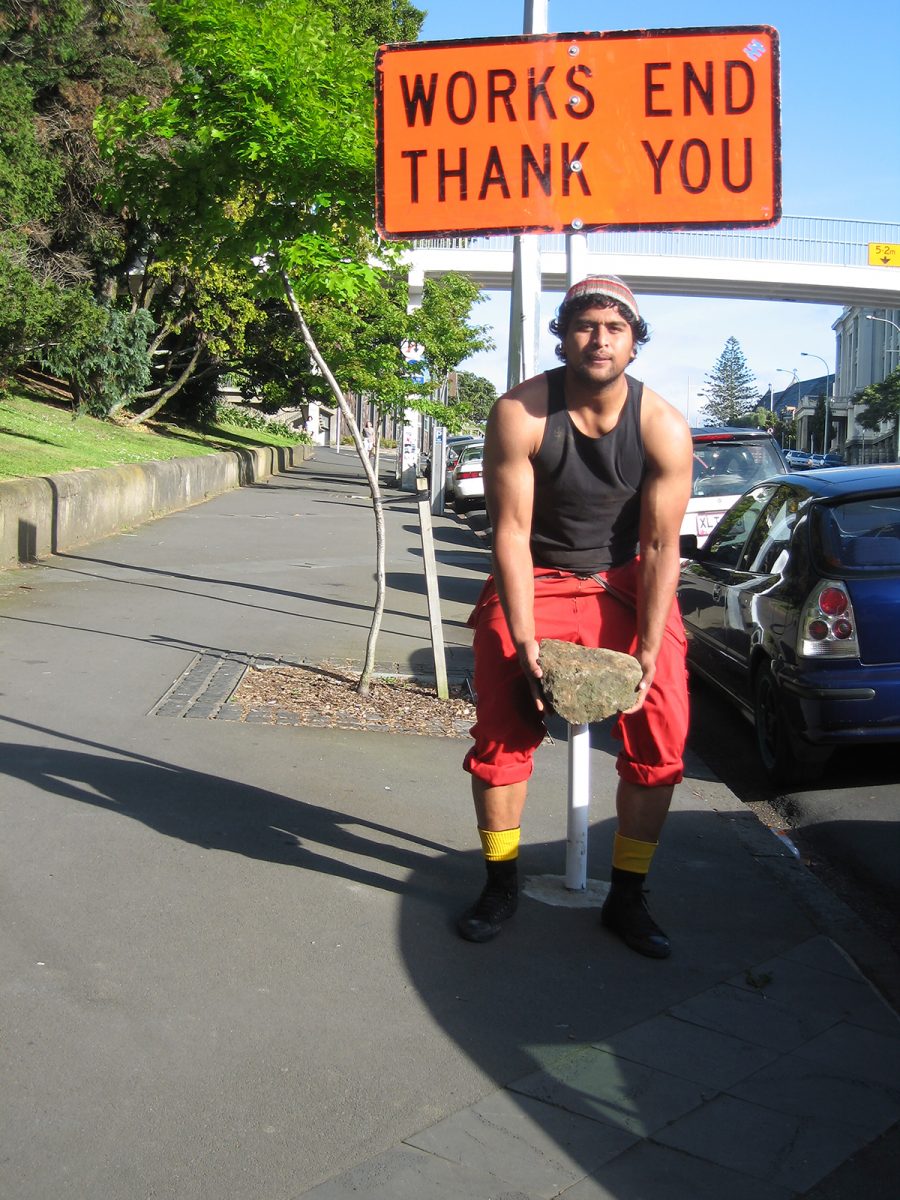
John Vea, If I pick your fruit, will you put mine back, photo courtesy the artist and Liveworks 2019
Pacific fightback
I’m particularly attracted to John Vea’s If I pick your fruit, will you put mine back, which will be exhibited at the 4a Centre for Contemporary Art while the performances will be presented at Carriageworks. Vea’s focus is on the experiences and especially the exploitation of the migrant workers of the Pacific. With incisive humour and apparently journalistic rigour, Vea, a Tamaki Makaurau (Auckland) based sculptor and video and performance art maker, will present stories he’s gathered from people in New Zealand and across the region. The title of the work of course alludes to Deputy Prime Minister Michael McCormack’s recent outrageously callous claim that the Pacific Islands will survive climate change because their workers will be able to come here and “pick our fruit.” Vea’s performances, which are free, will take place 8.00am-1.00pm at the Carriageworks Market on both Saturdays of Liveworks.
Talking the limits
Samara Hersch, whose Body of Knowledge invites teenagers to phone in their thoughts about sexuality, pleasure, shame, consent and more to Liveworks in “a meditation on age and change” will join Joel Bray with host Roslyn Oades, a verbatim theatre specialist, in a conversation about the limits of contemporary performance in respect of consent and the participating audience. Also on the program is writer and scholar Theron Schmidt, in a discussion with artists Brian Fuata and Sarah Rodigari on issues arising from his LADA (London’s Live Art Development Agency) commissioned book AGENCY: A Partial History of Live Art “exploring how and when we make possibility for action in the face of what oppresses us.”
Jeff Khan’s 2019 Liveworks program, which also includes the epic performative Day for Night party and the new nightly live music Sonic Nightcap program, is packed with works that should delight and challenge, an invaluable focus on women artists working in sound, four hugely attractive dance works, and plenty of opportunities for artists and audiences to talk through issues and responses. Intimate, talkative and provocative Liveworks will be a vital restorative in these tough times.
–
Performance Space, Liveworks 2019, Carriageworks, 17-27 Oct, 2019
Top image credit: Gail Priest, A continuous self-vibrating region of intensities, Gail Priest & Thomas Burless, image courtesy the artists


